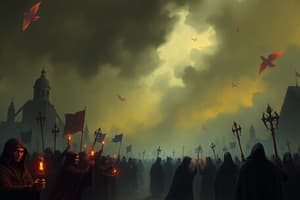Podcast
Questions and Answers
What was one of the primary ways the Black Death spread across Europe?
What was one of the primary ways the Black Death spread across Europe?
- Via airborne transmission in rural areas
- Through trade routes only by sea
- Through contaminated water supplies
- By person-to-person contact and flea bites (correct)
How did the Black Death impact Europe’s population growth between 1200 and 1400?
How did the Black Death impact Europe’s population growth between 1200 and 1400?
- Population doubled in size compared to pre-plague levels
- Population growth accelerated beyond previous levels
- Population levels remained stable without significant change
- Population growth was reversed to fall to levels seen in 1200 (correct)
What symptoms did victims of the Black Death commonly experience?
What symptoms did victims of the Black Death commonly experience?
- Persistent coughing and fever only
- Loss of appetite and fatigue mainly
- Severe headaches and stomach pains
- Black blotches on skin and boils (correct)
What actions did town officials take to manage the spread of the Black Death?
What actions did town officials take to manage the spread of the Black Death?
What social changes did the Black Death trigger among the population?
What social changes did the Black Death trigger among the population?
Flashcards are hidden until you start studying
Study Notes
The Black Death Overview
- The Black Death significantly reversed population growth in Europe.
- Likely originated in Central Asia and spread via Mongol armies and traders carrying infected fleas.
Spread of the Plague
- In 1346, Mongols attacked Kaffa on the Black Sea.
- Genoese traders in Kaffa transported the plague to Italy and southern France in 1347.
- The epidemic lasted two years, with some areas losing up to two-thirds of their population.
Impact on Population
- Average fatalities in western Europe reached one in three.
- By 1400, Europe's population returned to levels seen in 1200, with significant delays in recovery.
Symptoms and Effects
- Victims experienced severe symptoms: boils the size of eggs, black skin blotches, foul odors, and excruciating pain.
- Death usually occurred within a few days of symptom onset.
Responses to the Plague
- Town officials implemented measures like closing gates to infected individuals and burning possessions to curb the spread.
- Despite efforts, these measures could not fully prevent disease dissemination.
Nature of Bubonic Plague
- Bubonic plague was the primary form of the Black Death, transmitted person-to-person and through flea bites found on rats.
- Urban hygiene issues made it difficult to eliminate rat populations, aggravating the spread.
Societal Reactions
- The plague prompted varied responses; some people sought religious atonement, while others indulged in hedonistic behaviors.
- Increased church donations and self-flagellation became prevalent among the devout.
Long-term Effects
- Recurring outbreaks of plague contributed to slow and uneven population recovery in Europe.
- Significant demographic impact delayed the rise in population above preplague levels until after 1500.
Studying That Suits You
Use AI to generate personalized quizzes and flashcards to suit your learning preferences.




